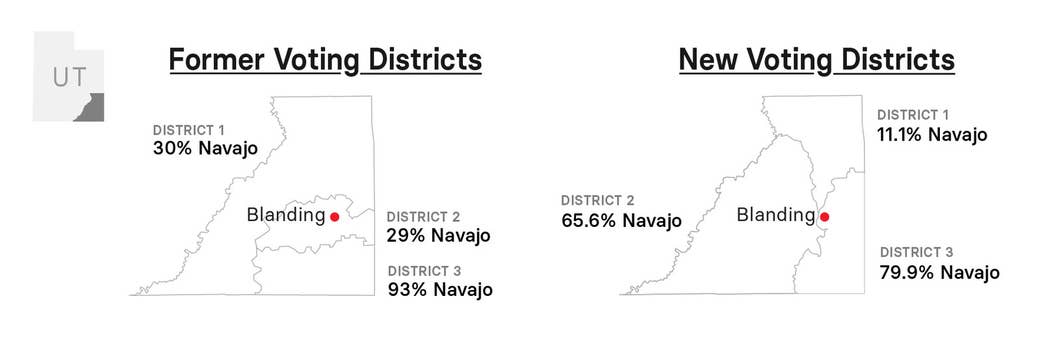2018 has been another wild ride for redistricting across the U.S., as gerrymandering cases at the federal and state level have upended district plans and may even sway the outcome of who controls the U.S. House. All told, at least 31 million Americans will be voting in new local, state, or Congressional districts for the election next week.
We keep track of legislative district changes and elections for our Cicero product. Here’s a look at where Congressional, State and Local districts in the U.S. are changing this year and why.
Pennsylvania
In a highly-publicized case that could reshape the outcome of who controls Congress, Pennsylvania’s Congressional districts were remanded earlier this year. In what many called one of the most aggressive gerrymanders this decade, the remanded plan featured some of the most ridiculed districts in the country such as the “Goofy kicking Donald Duck” Seventh District. We wrote about the gerrymandered plan in detail.
The Pennsylvania Supreme Court ruled the districts violated the state constitution and ordered a new map be put into effect in time for the election. Nathaniel Persily, a Stanford Law School Professor and go-to redistricting expert, was tapped by the Court to draw a new plan after the Governor and legislature failed to agree on a map. Just this week the U.S. Supreme Court declined to hear an appeal from the stage legislature, meaning the plan will be in effect until 2022. This is an important win against gerrymandering not just in Pennsylvania – it signals some precedent that the U.S. Supreme Court may stay out of cases where a State Supreme Court has ruled on the constitutionality of a redistricting plan.
Pennsylvania U.S. House Districts
North Carolina
Another state with districts in turmoil for years is North Carolina. After a new Congressional plan was adopted in 2016, the state legislative districts were also ordered to be redrawn by a federal court. That court ruled that 28 of the state’s legislative districts were an illegal racial gerrymander. In June of 2017, that ruling was affirmed by the U.S. Supreme Court and the legislature devised a new plan. However, plaintiffs challenged the new plan – arguing that some districts were altered unnecessarily which diluted the black vote. A federal court agreed and ordered Nathaniel Persily to create another new plan which the legislature adopted. This plan altered fewer districts and was used for the primary in February. That plan was upheld – in part – by the U.S. Supreme Court in a ruling last June, arguing that the federal court overreached in redrawing districts in Wake and Mecklenburg counties. Therefore, districts voted in during the primary will be used for the general election, but districts subject to the partial order in Wake and Mecklenburg counties will likely be redrawn again for 2020.
The state isn’t done with new Congressional districts yet, either. A federal court ruled the state must redraw its Congressional districts in a ruling last August. Since it was too close to the election, the districts will stand this year and be redrawn for the 2020 Congressional election.
North Carolina State Senate Districts
North Carolina State House Districts
Alabama
While not garnering as much press as the other legal battles, an important case in Alabama last year struck down a racial gerrymander of state legislative districts. The plaintiffs in that case argued the state packed too many black voters into certain districts. After a lower court originally upheld the plan, the U.S. Supreme Court vacated that ruling and struck down a dozen districts as unconstitutional. The Alabama legislature was ordered to redraw the state’s legislative districts and did so last year. That plan will go into effect this year.
Cities across California
Past litigation around the California Voting Rights Act (CVRA) has been shaking up local politics in California for years. Signed into law in 2002, the CVRA makes it easier for minority groups to sue governments for diluting the strength of minorities in elections. Proponents of the CVRA argue that one way cities do this is through having at-large elections rather than district representation. Last decade, all three cases that went before the Court challenging at-large districts on the grounds of the CVRA were successful in eliminating at-large representation in favor of district representation. Since then, communities across California have been districting their city council representation. This year many are going into effect for the first time.
Other new districts
An important voting rights case in San Juan County, Utah, means the Navajo Nation will have fair representation on the County Commission. In 1983, the Department of Justice filed a complaint against the county arguing its at-large election system disapproropationaly favored white candidates in a County that was majority Native American. In a settlement, the County agreed to create commissioner districts. The County then didn’t redistrict for years – while the Native American majority district continued to grow – until it was forced to this year. This was a classic case of “packing” voters to reduce their influence overall. Another suit, first filed in 2012, has resulted in a fair redistricting of San Juan County which will go into effect for the election this year.

Tracking elections this year
With over 300 elections taking place this year at the national, state and local level for places we maintain data – our work here at Azavea is cut out for us. To help keep track of elections, redistricting and term dates we created this interactive table below. Use it to find out when your new elected officials take office, whether redistricting is taking place and what party currently controls the chamber.
Want to see who represents you and a visual of new districts where you live? Check out our Elected Officials and Districts tool. Credit for the redistricting morpher graphics goes to Noah Veltmen. I updated his D3 code to use v4, which you can find on my Github.
